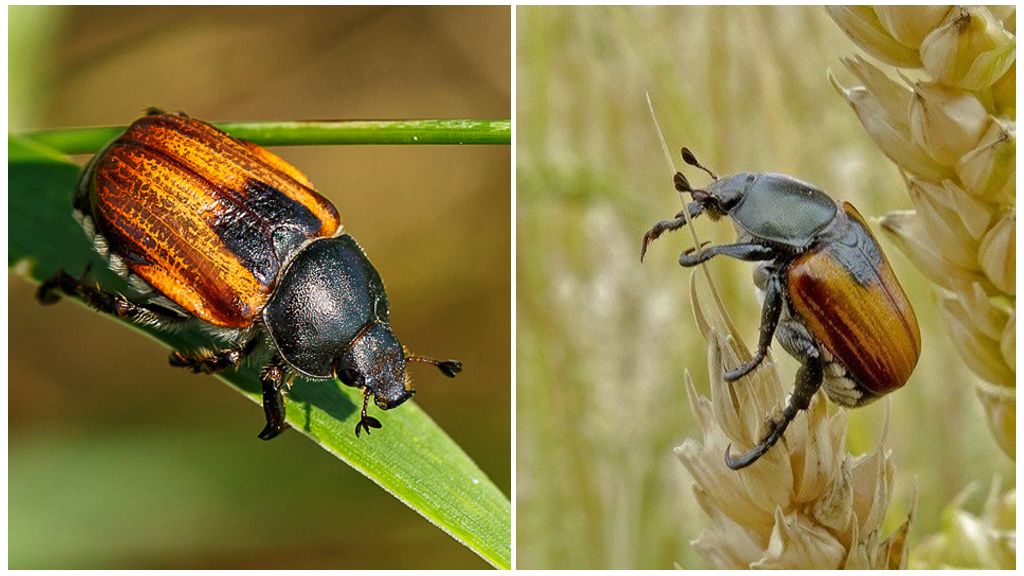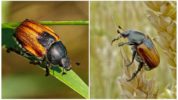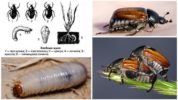- Bread Beetle
- Bread Beetle
A bread beetle, also known as a grasshopper, a sowing seed, a chipper (Anisoplia austriaca) is a dangerous pest of crops. Belongs to the family of lamellae. A medium-sized beetle - up to 16 mm, is widespread in the steppe, forest-steppe zone of Europe, and lives everywhere in Russia. Kuzka Bread likes sunny weather, in the evening he hides in a shelter - under piles of earth. With intensive reproduction, a pest colony can destroy an entire field of crops.
Description of appearance
The Kuzya Beetle is medium in size. Body length from 10 to 16 mm. The back is convex, abdomen, head is black with a green tint. Three pairs of short but tenacious legs. There are straight antennae on the head. The back or wings are bright brown, brown, reddish stripes. The female has a dark spot closer to the head on her back, this is outwardly different from the male. A photo of the bread bug is next.
Eggs are oval, white, dull. Larvae are thick white caterpillars bent by the letter “C”. Brown head, short legs, antennae. Size comes to 35 mm. Pupa yellowish, motionless, 17 mm long. Sensitive to high humidity, light.

Lifestyle
Kuzka - an insect, well adapted to drought, high humidity. Loves sunny weather, is active during the day. With the onset of twilight, it hides among the leaves of plants or under the breasts of the earth.
The goose sowing feeds on grain crops:
- barley;
- rye;
- wheat;
- wild cereals.
Adults eat ripening, ripe grains, second-generation larvae damage the root system of the plant, live in the ground.
On a note!
Females lay up to 100 eggs, then die, males die almost immediately after mating. The life cycle of an adult is 45 days. Larvae hibernate twice.
Breeding
The young generation of beetles appears in June-July. After a while, they begin to mate. Within a few weeks, eggs form in the body of the female. Female Khrushchiks burrow into the ground to a depth of 15 cm, lay eggs in heaps of 40-50 pieces. Upon completion of the process, the female dies without creeping out.
Embryos develop 3 weeks. Then larvae of the first age appear. The body size of the tracks does not exceed 5 mm. They feed on organics, plant roots. With the onset of cold weather they go down to 80 cm in depth, winter in a daze. In the spring, the development cycle continues.
Larvae of the second generation bread beetle live in the upper layer of soil, but during drought they go down. They damage the root system of crops, this damages the crop. With a large number of pests, the plant dies.

In the form of larvae, the hrushers hibernate one more time. In the spring they turn into a chrysalis. The process of becoming an adult lasts several weeks. In early June, the first batch of bread beetles appears.
On a note!
The economic threshold of harmfulness is determined by the number of hrushers per 1 sq. m. If, when examining the field, more than 5 bugs per 1 square. m, emergency measures are required.
Control measures
You can get rid of pests on the field using agricultural, mechanical, chemical methods. The choice depends on personal preferences, the number of mills, sown area.
- The agrotechnical method is stubble cultivation, deep autumnal plowing, cultivation.
- The physical control method involves manually collecting the bread beetles.
- Chemical - timely treatment of crops with insecticides.
To fight the bread bug, it was easier to combine several methods at once. Poison is recommended to be used in early spring, when the plant is just beginning the growth phase, spikelets have not formed. The most effective means Stop beetle, Karate Zeon, Euphoria, Parachute.
Interesting!
Agrarians noticed that the goose’s bread beetle damages the edges of the fields, while the crops in the center remain intact. They resort to tricks - less valuable crops are planted along the edge, the most significant ones in the depths of the field.
Often, folk remedies based on wood ash, tobacco are used to combat bread goose. The powders are mixed, poured with water, laundry soap is added. Damaged plants are sprayed.





